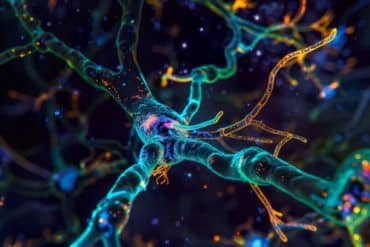Summary: Consuming seven or more units of alcohol per week is associated with increased iron levels in the brain. Higher levels of iron in the brain is linked to increased risk of neurodegenerative disorders and alcohol-related cognitive decline.
Source: PLOS
Consumption of seven or more units of alcohol per week is associated with higher iron levels in the brain, according to a study of almost 21,000 people publishing July 14 in the open access journal PLOS Medicine.
Iron accumulation in the brain has been linked with Alzheimer’s and Parkinson’s diseases and is a potential mechanism for alcohol-related cognitive decline.
There is growing evidence that even moderate alcohol consumption can adversely impact brain health. Anya Topiwala of the University of Oxford, United Kingdom, and colleagues explored relationships between alcohol consumption and brain iron levels.
Their 20,965 participants from the UK Biobank reported their own alcohol consumption, and their brains were scanned using magnetic resonance imaging (MRI).
Almost 7,000 also had their livers imaged using MRI to assess levels of systemic iron. All individuals completed a series of simple tests to assess cognitive and motor function.
Participants’ mean age was 55 years old and 48.6% were female. Although 2.7% classed themselves as non-drinkers, average intake was around 18 units per week, which translates to about 7½ cans of beer or six large glasses of wine.

The team found that alcohol consumption above seven units per week was associated with markers of higher iron in the basal ganglia, a group of brain regions associated with control of motor movements, procedural learning, eye movement, cognition, emotion and more. Iron accumulation in some brain regions was associated with worse cognitive function.
This is the largest study to date of moderate alcohol consumption and iron accumulation. Although drinking was self-reported and could be underestimated, this was considered the only feasible method to establish such a large cohort’s intake.
A limitation of the work is that MRI-derived measures are indirect representations of brain iron, and could conflate other brain changes observed with alcohol consumption with changes in iron levels.
Given the prevalence of moderate drinking, even small associations can have substantial impact across whole populations, and there could be benefits in interventions to reduce consumption in the general population.
Topiwala adds, “In the largest study to date, we found drinking greater than seven units of alcohol weekly associated with iron accumulation in the brain. Higher brain iron in turn linked to poorer cognitive performance. Iron accumulation could underlie alcohol-related cognitive decline.”
About this alcohol and neuroscience research news
Author: Press Office
Source: PLOS
Contact: Press Office – PLOS
Image: The image is in the public domain
Original Research: Open access.
“Associations between moderate alcohol consumption, brain iron, and cognition in UK Biobank participants: Observational and mendelian randomization analyses” by Topiwala A et al. PLOS Medicine
Abstract
Associations between moderate alcohol consumption, brain iron, and cognition in UK Biobank participants: Observational and mendelian randomization analyses
Background
Brain iron deposition has been linked to several neurodegenerative conditions and reported in alcohol dependence. Whether iron accumulation occurs in moderate drinkers is unknown. Our objectives were to investigate evidence in support of causal relationships between alcohol consumption and brain iron levels and to examine whether higher brain iron represents a potential pathway to alcohol-related cognitive deficits.
Methods and findings
Observational associations between brain iron markers and alcohol consumption (n = 20,729 UK Biobank participants) were compared with associations with genetically predicted alcohol intake and alcohol use disorder from 2-sample mendelian randomization (MR). Alcohol intake was self-reported via a touchscreen questionnaire at baseline (2006 to 2010).
Participants with complete data were included. Multiorgan susceptibility-weighted magnetic resonance imaging (9.60 ± 1.10 years after baseline) was used to ascertain iron content of each brain region (quantitative susceptibility mapping (QSM) and T2*) and liver tissues (T2*), a marker of systemic iron. Main outcomes were susceptibility (χ) and T2*, measures used as indices of iron deposition.
Brain regions of interest included putamen, caudate, hippocampi, thalami, and substantia nigra. Potential pathways to alcohol-related iron brain accumulation through elevated systemic iron stores (liver) were explored in causal mediation analysis.
Cognition was assessed at the scan and in online follow-up (5.82 ± 0.86 years after baseline). Executive function was assessed with the trail-making test, fluid intelligence with puzzle tasks, and reaction time by a task based on the “Snap” card game.
Mean age was 54.8 ± 7.4 years and 48.6% were female. Weekly alcohol consumption was 17.7 ± 15.9 units and never drinkers comprised 2.7% of the sample. Alcohol consumption was associated with markers of higher iron (χ) in putamen (β = 0.08 standard deviation (SD) [95% confidence interval (CI) 0.06 to 0.09], p < 0.001), caudate (β = 0.05 [0.04 to 0.07], p < 0.001), and substantia nigra (β = 0.03 [0.02 to 0.05], p < 0.001) and lower iron in the thalami (β = −0.06 [−0.07 to −0.04], p < 0.001). Quintile-based analyses found these associations in those consuming >7 units (56 g) alcohol weekly. MR analyses provided weak evidence these relationships are causal.
Genetically predicted alcoholic drinks weekly positively associated with putamen and hippocampus susceptibility; however, these associations did not survive multiple testing corrections. Weak evidence for a causal relationship between genetically predicted alcohol use disorder and higher putamen susceptibility was observed; however, this was not robust to multiple comparisons correction. Genetically predicted alcohol use disorder was associated with serum iron and transferrin saturation.
Elevated liver iron was observed at just >11 units (88 g) alcohol weekly c.f. <7 units (56 g). Systemic iron levels partially mediated associations of alcohol intake with brain iron. Markers of higher basal ganglia iron associated with slower executive function, lower fluid intelligence, and slower reaction times. The main limitations of the study include that χ and T2* can reflect changes in myelin as well as iron, alcohol use was self-reported, and MR estimates can be influenced by genetic pleiotropy.
Conclusions
To the best of our knowledge, this study represents the largest investigation of moderate alcohol consumption and iron homeostasis to date. Alcohol consumption above 7 units weekly associated with higher brain iron. Iron accumulation represents a potential mechanism for alcohol-related cognitive decline.







